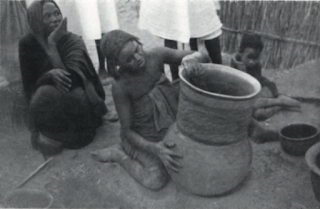Anthropomorphic vessel with breasts, Neolithic Lengyel culture (5000-3400 BC)
Anthropomorphic vessel with breasts and grain ears (?) instead of hands, Chalcholitic Baden culture (3600–2800 BC) which developed from Lengyel culture
I wrote about these two vessels in these posts, "Baden culture grain maiden" and "So Indoeuropean" and I asked the question: are we looking at this, grain goddess, later known as Demeter/Persephone? See the posture?
If you are interested in Demeter/Persephone you might also find this article "Who are Persephone's parents" interesting. It talks about snakes in Persephone/Demeter cult...
Now have a look at this:
Left: Anthropomorphic vessel with breasts, 3000-2000BC Troy, Turkey
Right: Anthropomorphic vessel with breasts and vagina, 3000-2000BC Lemnos, Greece
Interesting, right? This is obviously the same cultural trait, which first appeared in Neolithic Central Europe and then traveled down to Anatolia and Greece during Chalcolithic and Bronze Age...
We know that these areas were connected. The same type of butter churners was found from Central Europe, through Greece (Lemnos), Asia Minor (Troy) to Levant (Gilat) during the period 5000-1000BC...I talked about this in my post "Milk, butter, cheese"...
The distribution of butter churns could be just a sign of technological exchange along trade routes, if it wasn't for the fact that milk consumption was rare during this time, as it depended on milk tolerance, which is a genetic trait passed from parents to their children...
Does this mean then that these cultures were somehow related? I mean not just culturally, as seen by the female vessels found in both Central Europe and Greece and Anatolia, but also genetically? I know Lengyel and Baden genes (I2a, G2a). What about Troy, Lemnos, Gilat?
Maybe there are other examples of these "female pots" with raised arms? I didn't spend much time looking into this so any additional info would be appreciated...
Female pots...Female pots...Have you seen these female pots from Late Neolithic Chalcolithic Central Europe? With birth diver "M"(ama) symbol depicted on them? I talked about these pots in my post "Mama"...
Female pots...Female pots...Did you read my post "The female pots from Sudan", about the female pots with boobs used as granaries and the (likely) remnants of the Neolithic grain goddess cult found in Sudan?
Interestingly the female pots we are talking about served as urns...Remember the link between the pot and the "womb (of the mother goddess)" preserved in Nigeria, also (likely) remnant of the Neolithic grain goddess cult?
The same Neilithic grain goddess cult found all over Eurasia too. This cult probably originated in the Fertile Crescent in the first farming communities, and was from there spread to Europe, Asia and Africa...
The female pots symbolising the body of the grain goddess, mother earth, would explain all the pithos (large storage vessels used as granaries) burials found all over Western Anatolia in the 3rd millennium BC. You can read more about it in "Early Bronze Age Burial Customs in Western Anatolia"...
When and where did this custom appear first?








Hi. I would like to use a quote regarding 'living stone' from your blog post in my thesis please. Could you let me have your details so I can cite you correctly please? Fascinating read! Thanks in anticipation.
ReplyDeleteCarole
I would like to use a comment re. living stones in my PhD thesis. Could you let me have your name so I can cite you correctly please? My uni email is: C.V.Forrester_2018@hull.ac.uk
ReplyDeleteKindest regards
Carole